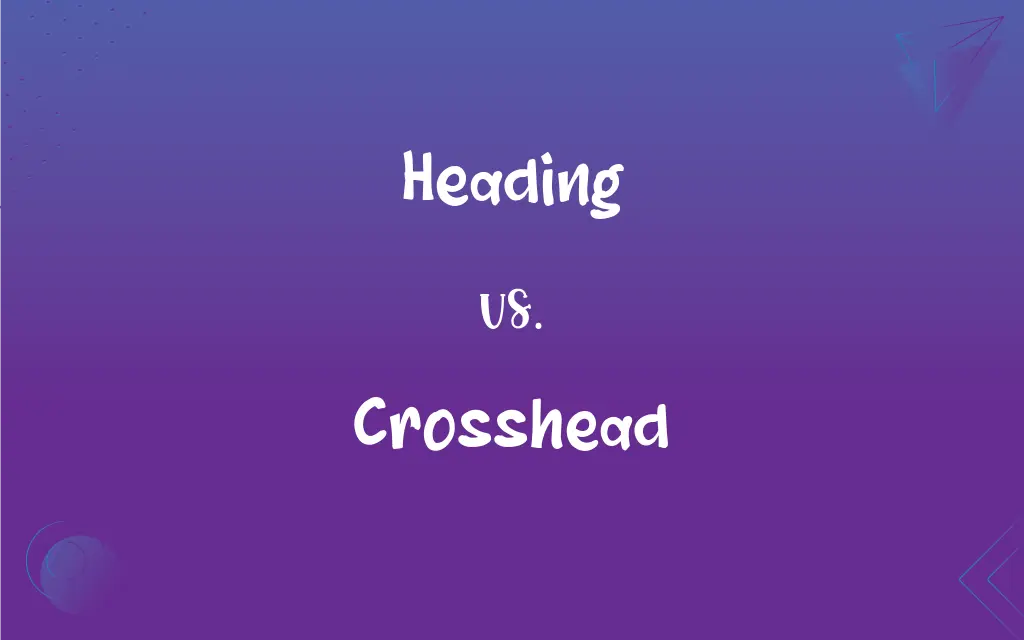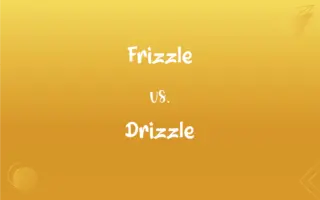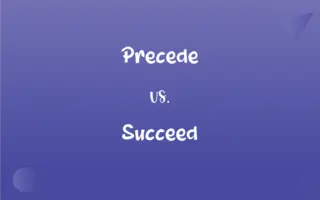Heading vs. Crosshead: What's the Difference?
Edited by Aimie Carlson || By Janet White || Updated on September 22, 2023
Heading is a title at the beginning of a section or paragraph; Crosshead is a secondary heading, often within a section, providing additional subdivision.

Key Differences
Heading and Crosshead are both typographical terms used predominantly in the layout of text to differentiate and categorize sections. A heading is typically a run-in line setting the title of an entire section or subsection of a document, providing an overview of the content that follows. It serves as a navigation aid by summarizing the ensuing text, aiding readers in locating specific content. Conversely, a crosshead is usually a subordinate heading, appearing within sections delineated by headings and serving to further subdivide content, providing additional specificity and granularity to the subject matter.
In the structuring of documents, a heading functions as a primary organizational tool. It stands prominently at the beginning of sections or paragraphs and is often differentiated through font size, style, or color. It categorizes information and provides a hierarchical structure to the content. In contrast, a crosshead acts as a supplementary organizational element, existing within the divisions created by headings, and offers more detailed subdivisions, allowing for nuanced segregation of ideas or information.
Headings are crucial in creating an outline or hierarchical structure in a document, enabling easy navigation and quick comprehension of the main topics. They create clear divisions and are often numbered or lettered to represent the structure explicitly. Crossheads, being secondary, provide a finer, more detailed level of categorization and division, allowing readers to delve into specifics, exploring subtopics or detailed aspects of the main topic outlined by the heading.
In terms of appearance, headings are often more prominent, with variations in size, boldness, or color to distinguish them from the main text. They capture attention and draw the reader to the content they represent. Crossheads, while also distinct, are usually less prominent than headings, providing a subtle guide to additional subdivisions within the content, offering nuanced insight into the material discussed under the main heading.
In conclusion, while both headings and crossheads serve to organize and structure content, headings play a pivotal role in delineating major sections and providing a macro overview, while crossheads offer a micro perspective, focusing on more detailed and specific subdivisions within those sections.
ADVERTISEMENT
Comparison Chart
Definition
Title at the beginning of a section or paragraph.
Secondary heading within a section providing subdivision.
Hierarchy
Primary organizational tool providing macro overview.
Supplementary, offers a micro perspective on subdivisions.
Appearance
Prominent, differentiated by size, style, or color.
Less prominent, subtle guide to additional subdivisions.
Function
Categorizes and structures content; aids navigation.
Provides detailed division and nuanced segregation.
Placement
At the beginning of sections or paragraphs.
Within the divisions created by headings.
ADVERTISEMENT
Heading and Crosshead Definitions
Heading
A title or caption at the beginning of a section or paragraph.
The heading Introduction provided an overview of the chapter's content.
Crosshead
A secondary title within a section giving more information about the content.
The crosshead Symptoms and Signs was listed under the Disease Overview heading.
Heading
The direction in which a vehicle or journey is moving.
The pilot checked the heading of the airplane.
Crosshead
A support structure for a beam or other load-bearing element.
The engineer inspected the crosshead for any signs of wear or damage.
Heading
A topic or subject under discussion.
Our main heading for today’s meeting is productivity.
Crosshead
A line of type set across a column or page to separate or highlight text.
The editor placed a crosshead to differentiate between the two topics discussed.
Heading
A categorization in a list or outline.
The heading Expenses was listed in the budget report.
Crosshead
A subdivision within a section, highlighting a specific aspect of the main topic.
The section on renewable energy had a crosshead focusing on solar power.
Heading
The title, subtitle, or topic that stands at the top or beginning, as of a paragraph, letter, or chapter.
Crosshead
A subordinate heading providing additional subdivision within a section.
The crosshead Market Analysis provided detailed insights under the Business Strategy heading.
Heading
The course or direction in which a ship or aircraft is pointing or moving.
Crosshead
A beam that connects the piston rod to the connecting rod of a reciprocating engine.
Heading
A gallery or drift in a mine.
Crosshead
(engineering) A metal beam that connects a piston to a connecting rod in an engine.
Heading
The end of a gallery or drift.
Crosshead
(journalism) Large text, like a headline but typically drawn from the article, placed partway through the article to break it up visually.
Heading
Present participle of head
Crosshead
A screw with a cross-shaped indentation for gripping and turning, as opposed to a flathead.
Heading
The title or topic of a document, article, chapter, or of a section thereof.
Put the information under the "Advantages" heading
Crosshead
A beam or bar across the head or end of a rod, etc., or a block attached to it and carrying a knuckle pin; as the solid crosspiece running between parallel slides, which receives motion from the piston of a steam engine and imparts it to the connecting rod, which is hinged to the crosshead.
Heading
(nautical) The direction into which a seagoing or airborne vessel's bow is pointing (apparent heading) and/or the direction into which it is actually moving relative to the ground (true heading)
Crosshead
A heading of a subsection printed within the body of the text
Heading
Material for the heads of casks, barrels, etc.
Crosshead
Metal block that connects to a piston; it slides on parallel guides and moves a connecting rod back and forth
Heading
(mining) A gallery, drift, or adit in a mine; also, the end of a drift or gallery; the vein above a drift.
Heading
(sewing) The extension of a line ruffling above the line of stitch.
Heading
(masonry) The end of a stone or brick which is presented outward.
Heading
(flags) A strip of material at the hoist end of a flag, used for attaching the flag to its halyard.
Heading
The act or state of one who, or that which, heads; formation of a head.
Heading
That which stands at the head; title; as, the heading of a paper.
Heading
Material for the heads of casks, barrels, etc.
Heading
A gallery, drift, or adit in a mine; the vein above a drift.
Heading
The extension of a line ruffling above the line of stitch.
Heading
That end of a stone or brick which is presented outward.
Heading
A line of text serving to indicate what the passage below it is about;
The heading seemed to have little to do with the text
Heading
The direction or path along which something moves or along which it lies
Heading
A horizontal (or nearly horizontal) passageway in a mine;
They dug a drift parallel with the vein
Heading
The name or title of a book, article, or chapter.
The heading of the article was captivating and intriguing.
FAQs
Can a document have headings without any crossheads?
Yes, documents can have headings without crossheads, depending on the level of detail and organization needed.
Can a heading and a crosshead have the same font size?
While usually different, they can have the same font size if distinguished by other means like boldness or underlining.
Can crossheads exist without a main heading?
Typically, crossheads exist within sections delineated by headings, but design variations can exist based on specific needs.
Are headings always bold?
Headings are often bolded for emphasis, but it is not a strict rule and depends on design preferences.
Can crossheads have numbering or bullet points?
Yes, crossheads can feature numbering or bullet points to indicate sequence or to organize information.
Can crossheads be omitted in academic papers?
Crossheads can be omitted if the paper doesn’t require additional subdivisions within the sections defined by the headings.
Are crossheads always centered?
No, crossheads can be left-aligned, centered, or right-aligned depending on the design and layout preferences.
Is the heading crucial for understanding the document structure?
Yes, headings are pivotal for providing an outline and hierarchical structure to the document, aiding in comprehension and navigation.
Can a crosshead be italicized?
Yes, crossheads can be italicized based on stylistic preferences or to convey a specific emphasis or tone.
Are headings necessary in all types of documents?
While not strictly necessary, headings are recommended for clarity and organization in most document types.
Can crossheads be used to highlight quotes or important points?
Yes, crossheads can be used to emphasize specific points, quotes, or information within a section.
Can headings be used interchangeably with titles?
While similar, titles usually refer to the name of the whole document or book, and headings refer to subdivisions within them.
Do headings need to be short and concise?
It’s advisable for headings to be concise to maintain clarity and ease of navigation, but there is flexibility based on content needs.
Can crossheads be longer and more detailed than headings?
Crossheads can be more detailed to provide specific insights into subsections, but conciseness is still valued for readability.
Is it essential to maintain consistency in heading styles throughout a document?
Yes, maintaining consistent heading styles is crucial for aesthetic coherence and to avoid confusion.
About Author
Written by
Janet WhiteJanet White has been an esteemed writer and blogger for Difference Wiki. Holding a Master's degree in Science and Medical Journalism from the prestigious Boston University, she has consistently demonstrated her expertise and passion for her field. When she's not immersed in her work, Janet relishes her time exercising, delving into a good book, and cherishing moments with friends and family.
Edited by
Aimie CarlsonAimie Carlson, holding a master's degree in English literature, is a fervent English language enthusiast. She lends her writing talents to Difference Wiki, a prominent website that specializes in comparisons, offering readers insightful analyses that both captivate and inform.































































